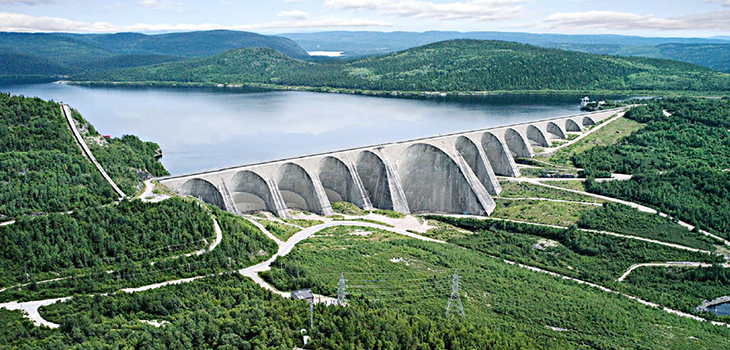
Patriot Battery Metals Unveils Major Lithium Resource Upgrade in Quebec, Establishing North America's Largest Deposit
Lithium Giant Emerges in Quebec: Patriot Battery Metals Redefines North American Supply Chain
JAMES BAY, Quebec — In the remote wilderness of Quebec's James Bay region, where pristine forests stretch to the horizon and crystalline lakes dot the landscape, a transformative discovery is quietly reshaping the future of electric mobility. Patriot Battery Metals announced latoday what market observers are calling a watershed moment for North America's critical minerals strategy: a massive upgrade to the mineral resource at its Shaakichiuwaanaan Lithium Project that catapults it to continental dominance.

The company's consolidated resource now stands at 108.1 million tonnes of indicated resources at 1.40% lithium oxide concentration, equivalent to approximately 3.75 million tonnes of lithium carbonate equivalent (LCE), with an additional 33.3 million tonnes in the inferred category at 1.33% lithium oxide. This represents a 30% increase at the primary CV5 pegmatite and a staggering 306% jump at the CV13 deposit compared to previous estimates.
Did you know? Lithium Carbonate Equivalent (LCE) is a standardized unit used in the lithium industry to express the amount of lithium in various compounds as if it were all in the form of lithium carbonate (Li₂CO₃). Since lithium is sold in different chemical forms—like lithium hydroxide or lithium chloride—LCE provides a common basis for comparing production, demand, and reserves. It’s essential for evaluating market size, pricing, and supply chain planning in the rapidly growing electric vehicle and battery sectors.
"What we're witnessing is the emergence of not just another lithium project, but potentially the cornerstone of North America's battery supply chain," said a veteran commodities analyst who has tracked the critical minerals sector for two decades. "The combination of scale and grade is exceedingly rare in this industry."
The Critical Timing of a Continental Champion
The resource upgrade arrives at a pivotal moment for the lithium industry. Despite an 85% drop in lithium prices since their November 2022 peak, experts anticipate a structural deficit beginning as soon as 2026, with demand projected to outstrip supply by 2.4 to 3.8 million tonnes of LCE by 2030.
Historical Lithium Carbonate Market Summary (2020-2025): Tracking price volatility from dramatic rise through correction phase, including current regional pricing and future outlook
| Period | Market Phase | Price Trend | Supply/Demand Situation |
|---|---|---|---|
| 2020-2022 | Dramatic Rise | Peaked at 5,750,000 CNY/tonne (Dec 2022) | Production: 82,000 metric tons (2020) |
| 2023-2024 | Market Correction | Continuous price deterioration | Surplus: 175,000 tons (2023), 154,000 tons (2024). Production reached 240,000 tons (192% increase) |
| 2025 (Current) | Continued Decline | -13.92% YTD, ~$10,400/ton globally. Regional prices: North America $8.49/KG (↓5.1%), Europe $11.04/KG (↓2%), NE Asia $8.35/KG, S. America $7.21/KG (↑0.4%) | Small surplus: ~10,000 metric tons |
| 2026 (Forecast) | Potential Stabilization | - | Potential small deficit: 1,500 metric tons |
This dichotomy—current oversupply coupled with looming shortages—has created what industry observers describe as a "cheap lithium, expensive optionality" environment. Battery makers and automakers are racing to secure future supply even as current prices remain depressed.
The strategic significance of Shaakichiuwaanaan extends beyond mere tonnage figures. As the largest lithium pegmatite indicated resource in the Americas and the eighth largest globally, it represents something more valuable: a geopolitically secure supply in an increasingly fractured global market.
"We're seeing a fundamental realignment of critical mineral supply chains," remarked an investment strategist specializing in battery materials. "Projects of this caliber within North America have become exponentially more valuable due to policy frameworks like the Inflation Reduction Act and the EU Critical Raw Materials Act."
Did you know? The Inflation Reduction Act (IRA) is reshaping battery material sourcing by requiring electric vehicle (EV) makers to use a growing percentage of critical minerals extracted or processed in the U.S. or allied countries to qualify for full tax credits—reaching 80% by 2027. Starting in 2024, EVs using battery components from "foreign entities of concern," like China, are excluded from incentives. These rules are driving major investments in domestic battery supply chains but also pose challenges due to limited local infrastructure and resource availability.
The Quebec Advantage in a Policy-Driven Market
Walking through the project site on a crisp morning, one can witness the careful ballet of exploration drilling alongside environmental monitoring stations—a dual focus that exemplifies Patriot's approach. The company has been conducting baseline environmental studies since 2021, working toward a feasibility study scheduled for completion in the third quarter of this year.

What distinguishes Shaakichiuwaanaan from competitors is not just its impressive resource numbers but its geographical and regulatory advantages. The project benefits from Quebec's low-carbon hydroelectric power infrastructure, provincial support for critical minerals development, and proximity to both U.S. and European markets.
These factors carry heightened significance given the Inflation Reduction Act's strict requirements for battery materials sourcing and the European Union's benchmark of 10% domestic extraction and 40% domestic processing by 2030.
A former provincial mining official who requested anonymity due to ongoing industry relationships emphasized these advantages: "Quebec has positioned itself as perhaps the most attractive jurisdiction in North America for battery materials development. The combination of infrastructure, clean energy, and governmental support creates a uniquely conducive environment."
Behind the Numbers: Geological Excellence with Room to Grow
The resource upgrade tells only part of the story. According to technical reports, the high-grade zones within the pegmatite—named Nova and Vega—demonstrate remarkable continuity, reducing mining risk and potentially enhancing economics.
Did you know? A pegmatite deposit is a type of igneous rock formation known for containing exceptionally large crystals and high concentrations of rare minerals. Formed during the final stages of magma crystallization, pegmatites are important sources of lithium, tantalum, niobium, and other critical elements used in electronics and batteries. Lithium-bearing minerals like spodumene are often mined from pegmatites, making these deposits increasingly valuable in the transition to clean energy and electric vehicles.
More telling is what remains unexplored. The deposit remains open along strike and at depth, with additional drill targets already identified at locations designated CV4, CV8, CV9, and CV10, suggesting potential for further resource expansion.
"What sets apart truly world-class deposits is not just current resources but expansionary potential," noted a geologist with experience in lithium exploration across three continents. "The structural setting and mineralization patterns at Shaakichiuwaanaan suggest we've only scratched the surface."
Corporate Chess: The Strategic Implications
For market participants, the announcement carries multi-layered implications beyond geological findings. Patriot Battery Metals—dual-listed in Canada, Australia, and the U.S.—sits at the nexus of several converging market forces.
The company's trajectory has drawn increased attention since Albemarle Corporation, the world's largest lithium producer, took a 5% stake in 2023. Industry insiders now speculate whether this resource upgrade might accelerate corporate interest in the project.
"The majors are shopping for top-quartile hard-rock assets while prices are low," explained a mining sector analyst at a Toronto-based investment bank. "Rio Tinto's recent $6.7 billion Arcadium bid demonstrates appetite for premium assets, and Shaakichiuwaanaan now clearly sits in that category."
The timing creates a fascinating dynamic: Albemarle recently paused expansion of its U.S. refining capacity, yet automakers continue seeking secure supply. General Motors' $192 million investment in Lithium Americas' Thacker Pass project signals ongoing strategic positioning by manufacturers.
"We're entering a phase where vertical integration and supply security trump short-term price considerations," said a battery supply chain consultant. "The question isn't whether Shaakichiuwaanaan will find a partner, but which type of partner—automaker, battery manufacturer, or major miner—will move first."
Community Relations: The Critical Path Forward
Perhaps the most significant factor in the project's timeline isn't geological or financial but social. While Patriot reports ongoing community engagement, no formal Impact-Benefit Agreement has been announced with the local Cree Nation, whose traditional territory encompasses the project area.
Historical precedent in the James Bay region suggests such agreements typically require 12-18 months of negotiation. This timeline could prove critical given the race to qualify for incentives under various clean energy legislation.
"The success of major projects in Quebec's north increasingly depends on meaningful partnership with Indigenous communities," observed a consultant specializing in Indigenous relations in the mining sector. "This isn't merely about consultation—it's about creating shared prosperity and environmental stewardship."
The Investor's Calculus: Pricing a Strategic Asset
For financial market participants, valuing Patriot Battery Metals presents a complex equation. With lithium equities down 60-80% from 2022 peaks, the sector presents value opportunities, yet execution risks remain.
Market observers outline several potential scenarios: a strategic offtake agreement with a North American automaker (45% probability); acquisition by a major mining company (30% probability); a slower development timeline due to persistent low prices or permitting challenges (20% probability); or significant permitting complications (5% probability).
"What we're pricing here isn't just current lithium value but optionality in a supply-constrained future," explained a portfolio manager at a resources-focused investment fund. "It's a high-beta play on the next lithium cycle, complicated by policy incentives that may put a floor under North American assets regardless of global price action."
Looking Ahead: The Feasibility Milestone
All eyes now turn to the feasibility study expected in the third quarter. This document will translate geological findings into concrete economic projections, mine design parameters, and formal reserve estimates.
For Patriot Battery Metals, the resource upgrade represents a crucial derisking step toward project financing. For North America's battery supply chain aspirations, it represents something more fundamental: a viable path to reduced dependency on overseas supply.
As dawn breaks over the Quebec wilderness, the drilling continues—each core sample bringing closer the day when this remote landscape might help power millions of electric vehicles across the continent.

"Shaakichiuwaanaan won't move spot prices in 2025," concluded a seasoned lithium market analyst, "but it may very well determine who controls marginal Western supply when the next deficit cycle hits. That makes it perhaps the most significant lithium development in North America today."